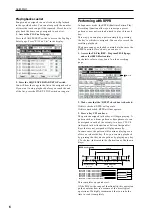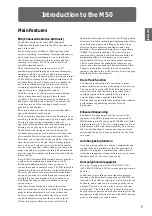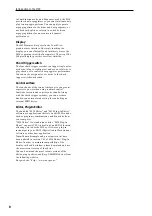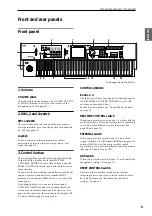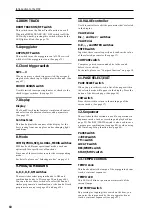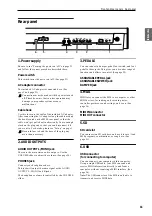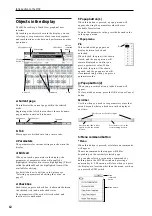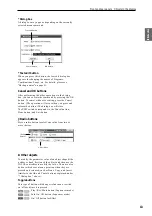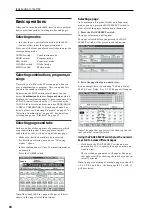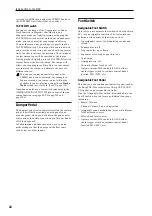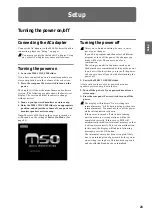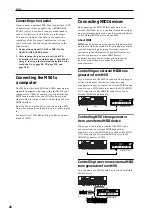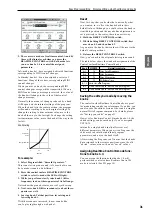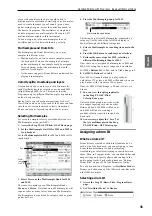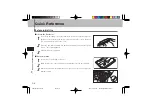
Introduction to the M50
20
For details, please see “Controller settings for the
program” on page 29.
When you write a Program or Combination, the on/off
status of the SW1 and SW2 switches is saved.
For details, please see “Setting the functions of SW1
and SW2” on page 18 of the Parameter Guide.
Using the Lock function
Locking the Joystick
1. Using the standard factory sounds, select Program
A033: Mild Suitcase E.Piano, and play the
keyboard.
To select a program, make sure that you are in Program
mode, and press the PROG BANK A switch, numeric
key 3, 3, and then the ENTER switch.
2. Move the joystick away from yourself (the +Y
direction).
The vibrato effect will deepen.
3. While holding the joystick away from yourself,
press the SW2 switch.
When you press the switch, its LED will light up, and
the modulation effect at this point will be maintained.
4. Release the joystick, and play the keyboard.
The modulation will stay the same as it was when SW2
was pressed. Moving the joystick away from yourself
will not affect the sound.
5. Press the SW2 switch once again to release the
Lock function.
Keyboard
Velocity
Velocity is a measure of how hard you play a note on
the keyboard. This can be used to modulate many
different aspects of the sound, such as volume,
brightness, or the character of the attack.
Note Number
Sounds can be programmed to change in character
based on the note being played.
As you play higher or lower on the keyboard, the note
number can modulate the timbre–such as becoming
brighter as you play higher. Envelopes may also
become faster or slower; the volume may change; and
so on.
Control Surface knobs
The control surface consists of four knobs, three control
assign switches REALTIME CONTROLS, EXTERNAL,
and ARP that select the functions that will be
controlled, and the RESET CONTROLS switch which
resets each function.
• You can apply modulation to sounds or edit them.
• You can control the arpeggiator.
• You can control external MIDI devices.
1. Press one of the REALTIME, EXTERNAL, or ARP
switches to select the group of functions that you
want to control.
Alternatively, you can use the Prog P0: Play– Control
Surface page Control Assign parameter to select a
function. Press the Control Surface tab in the lower line
of the display to access this page.
Since this parameter is linked with the front panel
switches, a change you make to one will be reflected by
the other.
In Program mode, you can select one of three different
functions:
Realtime Control:
Use the knobs to modify the sound
External:
Use the sliders and switches to transmit
MIDI messages to external MIDI devices. You can
assign these functions in the Global P1: MIDI– External
Mode 1/2 pages.
ARP:
Use the knobs to control the arpeggiator.
You can freely switch between these functions without
losing your current edits.
2. Operate knobs 1–4 to control the selected
functions.
At the minimum and maximum positions of the
knob, there will be a slight discrepancy between
the value and the position of the knob.
For details on control surface operation in each mode,
refer to the following pages.
Program mode: for details, please see “0–8: Control
Surface” on page 11 of the Parameter Guide
Combination mode: for details, please see “0–8:
Control Surface” on page 87 of the Parameter Guide
Sequencer mode: for details, please see “0–2–8: Control
Surface” on page 143 of the Parameter Guide
Summary of Contents for EASYSTART M50
Page 1: ...3 E Owner s Manual ...
Page 84: ...Arpeggiator function 78 ...
Page 88: ...Drum Track function 82 ...

